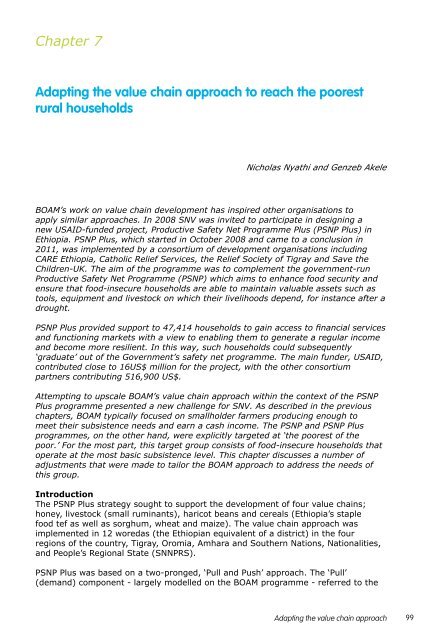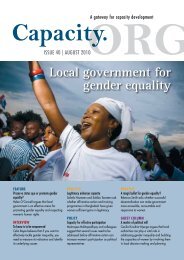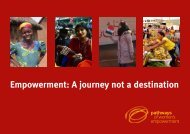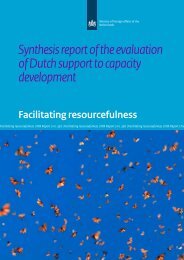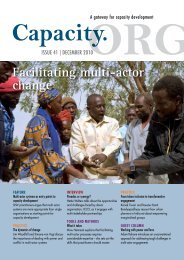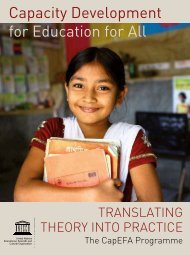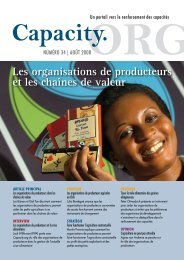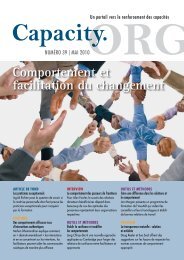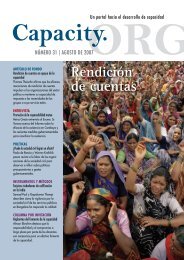Pro-Poor Value Chain Development - Capacity.org
Pro-Poor Value Chain Development - Capacity.org
Pro-Poor Value Chain Development - Capacity.org
You also want an ePaper? Increase the reach of your titles
YUMPU automatically turns print PDFs into web optimized ePapers that Google loves.
Chapter 7<br />
Adapting the value chain approach to reach the poorest<br />
rural households<br />
Nicholas Nyathi and Genzeb Akele<br />
BOAM’s work on value chain development has inspired other <strong>org</strong>anisations to<br />
apply similar approaches. In 2008 SNV was invited to participate in designing a<br />
new USAID-funded project, <strong>Pro</strong>ductive Safety Net <strong>Pro</strong>gramme Plus (PSNP Plus) in<br />
Ethiopia. PSNP Plus, which started in October 2008 and came to a conclusion in<br />
2011, was implemented by a consortium of development <strong>org</strong>anisations including<br />
CARE Ethiopia, Catholic Relief Services, the Relief Society of Tigray and Save the<br />
Children-UK. The aim of the programme was to complement the government-run<br />
<strong>Pro</strong>ductive Safety Net <strong>Pro</strong>gramme (PSNP) which aims to enhance food security and<br />
ensure that food-insecure households are able to maintain valuable assets such as<br />
tools, equipment and livestock on which their livelihoods depend, for instance after a<br />
drought.<br />
PSNP Plus provided support to 47,414 households to gain access to financial services<br />
and functioning markets with a view to enabling them to generate a regular income<br />
and become more resilient. In this way, such households could subsequently<br />
‘graduate’ out of the Government’s safety net programme. The main funder, USAID,<br />
contributed close to 16US$ million for the project, with the other consortium<br />
partners contributing 516,900 US$.<br />
Attempting to upscale BOAM’s value chain approach within the context of the PSNP<br />
Plus programme presented a new challenge for SNV. As described in the previous<br />
chapters, BOAM typically focused on smallholder farmers producing enough to<br />
meet their subsistence needs and earn a cash income. The PSNP and PSNP Plus<br />
programmes, on the other hand, were explicitly targeted at ‘the poorest of the<br />
poor.’ For the most part, this target group consists of food-insecure households that<br />
operate at the most basic subsistence level. This chapter discusses a number of<br />
adjustments that were made to tailor the BOAM approach to address the needs of<br />
this group.<br />
Introduction<br />
The PSNP Plus strategy sought to support the development of four value chains;<br />
honey, livestock (small ruminants), haricot beans and cereals (Ethiopia’s staple<br />
food tef as well as s<strong>org</strong>hum, wheat and maize). The value chain approach was<br />
implemented in 12 woredas (the Ethiopian equivalent of a district) in the four<br />
regions of the country, Tigray, Oromia, Amhara and Southern Nations, Nationalities,<br />
and People’s Regional State (SNNPRS).<br />
PSNP Plus was based on a two-pronged, ‘Pull and Push’ approach. The ‘Pull’<br />
(demand) component - largely modelled on the BOAM programme - referred to the<br />
Adapting the value chain approach<br />
99


